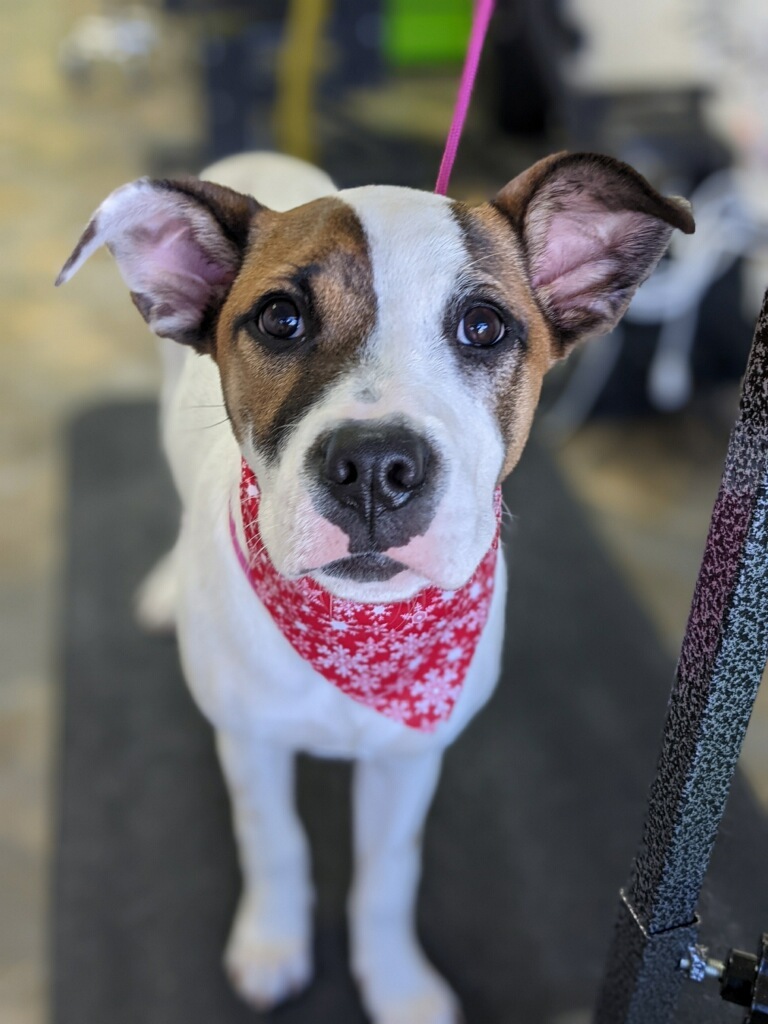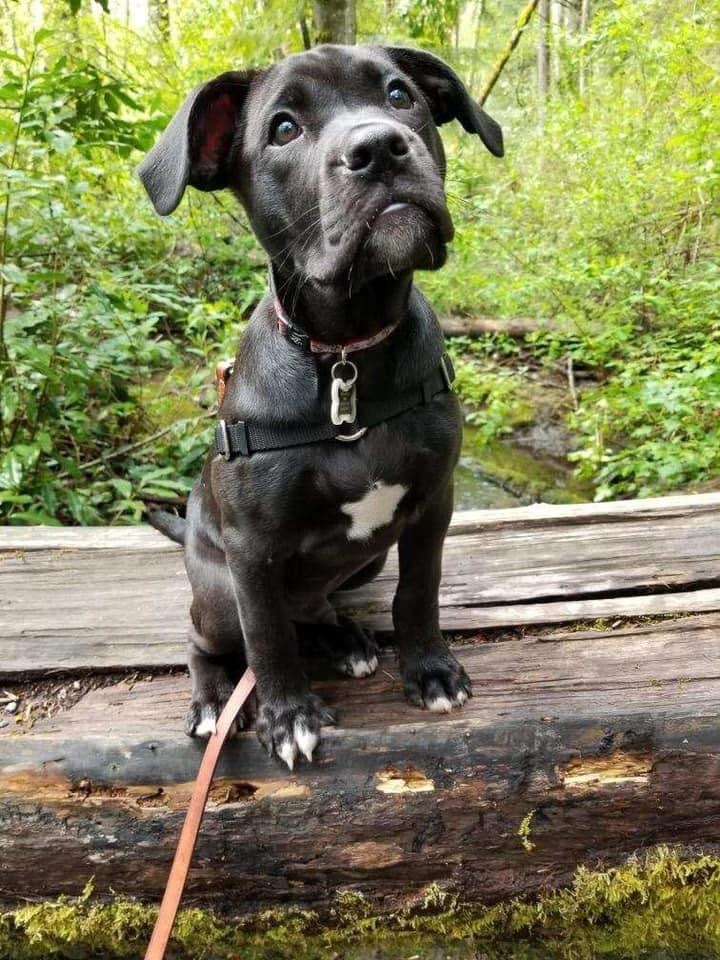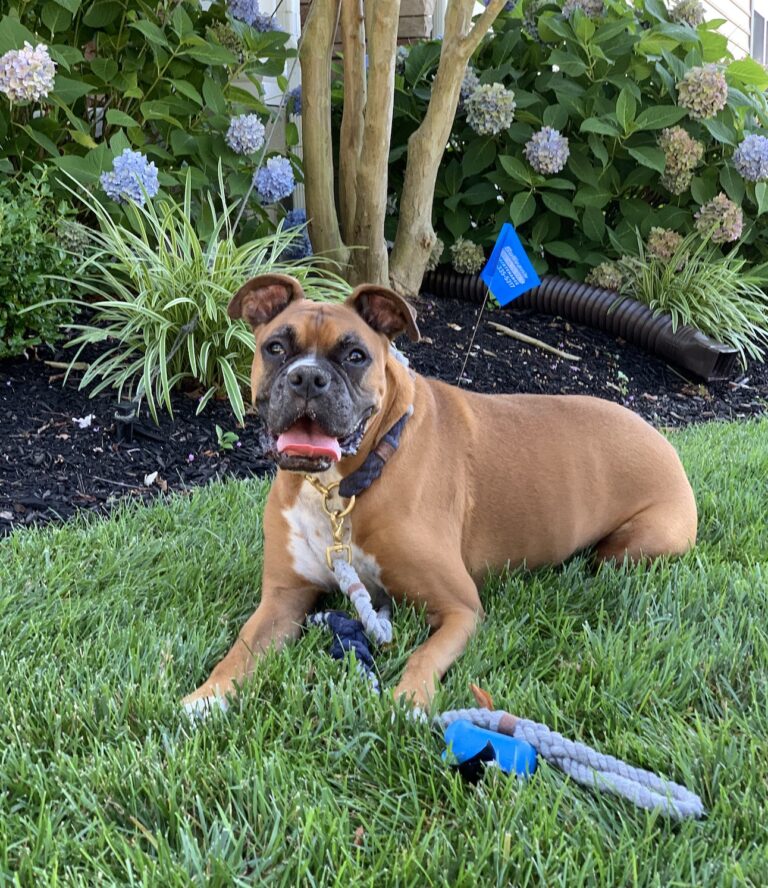Boxers combine an athletic physique with a fun-loving disposition. These dogs cut an impressive silhouette, with a broad chest below a square muzzle. But, lest you consider boxers “tough guys,” their mischievous eyes and famously wiggly butts betray cuddlier inclinations. First bred as working dogs in Germany, boxers landed Stateside after World War I, where they became, and remain, a popular companion for active families. For those considering bringing a boxer into their household, or for current owners looking to better understand their companions, here’s the lowdown on these handsome, charming dogs.
Keep in mind that, while dogs of a certain breed may share common characteristics, every dog is an individual shaped by unique genetics, experience, and environmental factors. Like humans, dogs have their own distinct personalities. Pay attention to what your pup is telling you about their needs!

Sadie
Basic boxer facts
Even casual dog people can identify a boxer. The breed’s distinctive muzzle is broad and blunt, or “chiseled,” per the American Kennel Club, and the stocky body emphasizes the chest. In the past, it was customary to crop boxers’ naturally floppy ears to make them stand erect, and to crop their long tails. These practices have waned, and the American Veterinary Medical Association (AVMA) opposes ear cropping and tail docking when performed for cosmetic purposes. On average, boxers stand about 21.5 to 25 inches from floor to shoulder; a small female can weigh as little as 50 pounds, and a large male can be up to 80 pounds. Color-wise, the short coat is generally light brown—called “fawn”—or has a brindle pattern, and white flashes are typical. All-white boxers are also common.
About that butt…
Historically working dogs, boxers have a build that means business. The strong chest conveys a sense of momentum, even when standing still. In motion, a fit boxer runs with speed and elegance. But the boxer personality always shines through. When not zipping about, that powerful body is prone to “kidney beaning,” bending into a head-to-tail semicircle and spinning about. “It’s the cutest thing in the world!” says Susan Mccown, owner of a boxer named Penny.
“Butt wiggles! Anytime Booker gets excited, his entire body wiggles from his butt up to his snoot. It’s entirely wonderful. He cannot contain his exuberance.” —Booker’s human, Lizzie Mazlin
Another signature move is the rear-end wiggle, whether done as a standing dance move or to snuggle into a prime sofa position. “Boxers are wiggle butts,” says Lisa Barker, director of New England’s The Boxer Rescue. “I have a T-shirt that says ‘Wiggle Butt Club.’”
The boxer’s social and affectionate personality
“Boxers are goofy, protective, high-energy [dogs],” says Barker, “and they love to be with their people.” Hanna Jung, owner of Jax, is in total agreement. “Boxers are very playful and goofy,” Jung says. “They have a signature butt wiggle that can make any heart melt because you know they are super excited and happy to see you.”
Up front, the boxer’s face enhances the endearment with expressive eyes and eyebrows, revealing the winning personality within, which helps explain why boxers are the eleventh most popular breed in America according to the AKC. “You never have to [guess] what a boxer is thinking—their expressions are incredible,” says Melanie Mosier of Carolina Boxer Rescue. Boxers mature slowly, reaching adulthood around age three, so puppy traits can extend well beyond the traditional bouncy period of other dogs. “T-Bone is 10 years old,” says boxer owner Jesse Shaver, “but he still acts like a goofy little puppy sometimes!”
An adult boxer is likely to be moderately open toward strangers and very affectionate toward their human family, including children. Boxers seek both emotional and physical connection. “These dogs want and need to be with their people; they’re like Velcro,” Barker says. “I work at home and the dog is on my feet. I move to the other room and the dog is on my feet.”
“When we brought our first son home, I was worried how T-Bone would react,” adds Shaver. “It has been so sweet watching how T-Bone has bonded with them. From day one, he has been so gentle and sweet to them—napping together, trying to sneak in a lick on their face or toes.” Boxers enjoy playing and, as innate athletes, are up for games of any kind. They are gifted runners, so using a leash and/or fence outside is nonnegotiable.
The breed exhibits average interest in other dogs and is usually game to engage, though boxers are primarily “people dogs.” More boisterous than aggressive, boxers can be intimidating to children and those not used to their exuberance, and youngsters should be supervised in case intended fun gets too intense. Same goes for playdates with other dogs. Even downtime can turn active with a boxer. A 75-pounder will earnestly attempt to occupy a human lap or snuggle impossibly close on the couch.
The boxer’s German roots
The breed descends from a now-extinct dog called the German bulldog, or Bullenbeisser, which means “bull biter.” In the 1800s, Bullenbeissers, long considered a hunting companion for the diminishing noble class, inspired breeders to develop a smaller, genteel dog to help guard and live with more modern households. By 1870, breeders were crossing the German breed with the Old English bulldog, also now extinct, and it is from this blend that today’s boxer emerged.
Like their ancestors, boxers are brachycephalic, or flat-nosed, with a broad, short muzzle and underbite. Breeders in Munich had established the first boxer club by 1895, and the dog soon spread to other parts of Europe. Across the Atlantic, the American Kennel Club registered its first boxer in 1904, after which the breed’s popularity steadily grew. In 1951, a boxer named Bang Away won best in show at Westminster, solidifying the dog’s status as an American favorite.
Despite their popularity and star-making personality, boxers don’t yet have one super-prominent silver screen breed representative like German shepherds do in Rin Tin Tin. Still, boxers have played supporting roles in films like 2003’s Good Boy, and are no strangers to the world of celebrity: they’ve been companions to many A-listers, including Cameron Diaz, Hugh Jackman, and Justin Timberlake. During Hollywood’s golden age, Humprey Bogart and Lauren Bacall owned several boxers, and the dogs often appeared in photos with the couple.
Finally, no list of notable boxers is complete without a shout-out to Brandy, whom Guinness World Records recognizes as the dog with the longest tongue in history. Its length? An impressive 1 foot, 5 inches. Brandy passed away in 2002, but her magnificent tongue remains unmatched.
Why the name “boxer?”
Nobody knows with certainty how boxers got their name. Mainstream lore contends the moniker stems from the dog’s tendency to mimic a human pugilist by standing on hind legs and swatting their paws. Owners confirm that this theory makes sense. “Maggie likes to ‘box’ at us with her paws when she wants something,” says Kelly Bridges.
Others believe that the “boxer” name may have been shortened from “bierboxer,” a word used in Germany to describe dogs descended from the Bullenbeisser. Another possibility comes from Charles Dickens’ 1845 novella The Cricket on the Hearth, whose main character has a dog named Boxer. The book may have sparked or reflected a trend to use Boxer as a common dog name.

Roo
Training tips for boxers
Boxers are of average working intelligence, according to Stanley Coren’s oft-referenced rankings, which sort dogs by how quickly and reliably they follow commands. By this measure, they’re similar to greyhounds, dachshunds, and great Danes. Of course, any brain is the product of experience and environment, so boxers benefit from mental stimulation, training and exercise, and overall good health habits.
“Boxers are fantastic family dogs, but training needs to be a part of their lives,” says Mosier of Carolina Boxer Rescue. “[They] are incredibly smart, but a bored boxer is a destructive boxer.”
Start socializing your boxer early with both humans and other dogs, and enroll in training classes as soon as you can. The breed excels at problem solving, as opposed to repetitive drills, and responds best to firm yet positive feedback. Recall the upbeat personality!
“Because they are known as being goofy, hyper, the class clowns, and stubborn as can be, people often say boxers are untrainable,” says owner Karey Wolfrey. “Well, Mr. Nugget begs to disagree with this assessment.” (His therapy dog certificate and obedience awards back him up.) Boxers and their ancestors historically worked as guard and hunting dogs—Bullenbeisers chased and held wild boar and other prey for human hunters—and today many find employment as police dogs and service animals, more evidence of the breed’s aptitude.
Some owners recommend a quick stroll before an obedience class to help the boxer mentally prepare for training. One important training focus for these powerful, energetic dogs is helping them master the “down” command and control their urge to jump on and around those near them. Starting early will improve training’s odds of success, as will finding the right incentives for your dog. “Sadie is very treat-motivated to train,” says Lynette Bolanos of her boxer. “She learns very quickly. I think she is so smart, but actually chooses to ignore me sometimes.” If your boxer seems to be bored or unmotivated, try mixing up training tasks or rewards to find something effective—and keep training sessions short.

Booker
Exercise both mind and body
Born athletes, boxers are devout exercisers who get antsy without ample daily physical activity. “They do best with an active family or couple that likes to walk or hike,” says Barker of The Boxer Rescue. “These dogs need two to three walks a day.” They are also habitual chasers who should never roam freely lest they literally run into trouble. As with humans, ease into any exercise routine. For mature dogs, two to three half-hour walks a day is a solid goal, then supplement during the week with longer, brisker jaunts and maybe a game of catch. Boxers often like to play fetch with a ball or catch a Frisbee. “These dogs need to be exercised both physically and mentally,” Barker adds. So don’t just do the same thing over and over again; mix up your play sessions, and consider enriching your boxer’s day with challenges like food puzzles.
A note of caution: Very hot or very cold weather does not agree with boxers’ brachycephalic muzzles and short coats, so avoid outdoor exercise during extreme temperatures. And white boxers’ skin is extra sensitive, so protect them from direct sunlight and consider using a vet-approved sunscreen if they’re going to be outside for an extended period.
Grooming for boxers
Grooming is not a big issue with boxers, thanks to their short coats. Regular use of a firm bristle brush will keep your boxer sleek and help prevent shedding, which they do excel at. While brushing, keep in mind how taut boxers’ coats can be; go gently over delicate parts like joints, tendons, and the head. In any case, bathe a boxer only when needed—about every few months, unless they get visibly dirty or noticeably smelly.
Your boxer may help keep themselves tidy; some owners report them cleaning themselves like cats. Despite such fastidiousness, though, boxers can be prolific droolers—so keep wipes handy.

Penny
Common boxer health concerns
Boxers in good health can live from 10 to 12 years. In addition to the challenges most breeds can face—arthritis, obesity, fleas and ticks, gum disease—boxers are particularly susceptible to the following health concerns.
Cancer: Boxers are predisposed to several types of cancer, notably malignant skin lesions. Avoid direct sun and apply dog-safe sunblock or use sun-protective clothing. Watch for any growths or irregularities on your boxer’s skin and inform a vet if anything changes. As with humans, early detection is key and not all growths are malignant. Treatment options such as excision are often successful. “We just had two mast cell tumors removed from her with the hopes no more evolve,” says Melody Russell of her boxer Dixie.
Below the surface, boxers are at risk for cancers of the blood, brain, and other organs. No test can predict if a boxer will develop cancer, so ensure your dog gets exercise, healthy food, and regular visits to the vet, who should be informed of any concerns. Cancer treatments include surgery and chemotherapy.
Bloat: Boxers are one of the breeds most likely to suffer from bloat and gastric dilatation-volvulus (GDV), in which the stomach fills with too much gas and twists onto itself. If you notice unproductive belching or a distended belly in your dog, go to a veterinarian immediately. GDV is a medical emergency and one of the most common causes of death among dogs, and minutes can make the difference between a dog passing away and surviving.
Heart diseases: Boxers are predisposed to a condition called arrhythmogenic right ventricular cardiomyopathy (ARVC), also known as boxer cardiomyopathy. This disease causes the heart to beat abnormally by disrupting its electrical signals, thus disrupting the consistent circulation of blood. It can cause weakness, collapse, heart failure, or death. Get medical attention at any sign of sudden weakness. Triggers of a cardiomyopathy episode can include heat stroke (again, keep boxers in a climate-controlled environment and avoid strenuous activity during hot weather), poisoning, and other diseases. A vet can test your boxer’s blood to reveal a predisposition for cardiomyopathy, which generally arises in adulthood. The vet may want your boxer to wear a heart monitor occasionally to keep tabs on the organ’s condition.
A second cardiological concern for boxers, aortic stenosis, is a narrowing of the aortic valve, through which oxygenated blood travels from the heart into the rest of the body. Weakness, fainting, and death can occur. Dogs with milder cases may behave normally; signs in more severe cases may resemble those in heart failure—so look for coughing, exercise intolerance, collapse, and open-mouth breathing. This is a congenital condition that a vet can typically detect by listening to a dog’s heart and chest, followed up by an x-ray or electrocardiogram and echocardiogram. Sometimes a puppy is too young for aortic stenosis to be diagnosed, but it will be evident as the dog’s heart matures. Mild cases may not require treatment, other than restricting exercise and other activities that can strain the heart. Medication—such as a beta blocker to slow the heart—is an option for advanced aortic stenosis, and there are surgical options for the right candidates.
Boxers are among the breeds prone to another heart condition, DCM (or dilated cardiomyopathy), wherein the heart muscle wears thin and loses its ability to contract normally and pump blood effectively through the body (read more about DCM here).
Degenerative myelopathy: If you’ve ever seen a dog, perhaps a boxer, on a wheeled cart supporting their back legs, that animal was likely experiencing degenerative myelopathy, a neurological disease that disrupts the spinal cord’s ability to control the rear legs and hind quarters. It is more common in middle age and beyond, and, in addition to mobility, can affect continence. A blood test can determine a dog’s risk of developing degenerative myelopathy. Properly diagnosing the disease can require several tests, with a biopsy of the spinal cord the only way to get a definitive diagnosis. Signs include back legs that progressively become wobblier or weaker, advancing to paralysis.
Hip dysplasia: Hip dysplasia is a serious condition that can cause pain, hinder a boxer’s mobility, and lead to arthritis. It occurs when the hip joint’s ball-and-socket connection doesn’t fit together smoothly. Tell your vet if your boxer is newly struggling to walk or climb, which indicates that the hip is difficult to move or is hurting. The condition is generally inherited, but injury, diet, exercise and growth rate can play a role. Treatment options include pain medication, nutritional supplements to support joint health, and hip-replacement surgery.
Hypothyroidism: When a dog has hypothyroidism, the thyroid gland doesn’t produce and release enough hormone. Thyroid hormone regulates the body’s metabolism, so a boxer whose thyroid isn’t making enough may experience sluggishness, weight gain, hair loss, digestive issues, and many other symptoms. Hypothyroidism is serious, and may be the result of a thyroid tumor. If it goes undiagnosed and untreated, symptoms will get worse—so if you suspect an issue, visit a veterinarian. They will check your boxer for hypothyroidism by feeling the thyroid gland at the front of the neck, listening to their heart, and discussing any signs you’ve noticed. Finally, a blood test will provide the definitive answer. There is no cure, but treatment options include hormone-replacement medicine and, if applicable, surgery to remove a tumor. On a positive note, if treatment starts early, boxers with hypothyroidism can expect a good-quality long life.
Histiocytic ulcerative colitis (HUC): Rare but serious, histiocytic ulcerative colitis, or HUC, is an inflammatory bowel disease that mainly strikes boxers. It is also called boxer colitis. The cause is unknown, but suspects include genetics and a triggering infection from E. coli or another agent. HUC inflames and ulcerates the lining of the large intestine, which results in bleeding and extensive inflammation.
An afflicted boxer may have loose or mucus-y stools or strain to defecate, leading to discomfort, lack of appetite, and weight loss. Treatment options for this chronic condition include medication and adjustments to the type and timing of food.
Food and nutrition for boxers
Like all dogs, boxers need digestible, complete, and balanced food that supplies enough energy for daily activities like butt-wiggling while helping maintain a healthy weight. Here is some more food for thought.
Watch their weight: Extra weight puts additional stress on a dog’s heart, joints, and metabolism, so it’s important to control their portions and calorie intake while ensuring proper nutrition. Keeping your boxer in an ideal body condition can improve their chances of continued good health. A fresh-food plan makes it easy to feed the right amount of food for their age, size, and activity level.
Support heart and joint health: A fresh diet that provides balanced Omega-3 fatty acids may promote cardiac health and help ward off joint issues. A pre-portioned fresh food plan also makes it easy to feed the right number of calories every day. This helps maintain a healthy weight, which is another key factor in keeping heart and joints healthy, as well as improving general health quality of life.
Mind the teeth: Eating for dental health means eating for overall health—a fresh, whole-food diet promotes a healthier immune system, which helps ward off dental maladies. Crunchy kibble is often said to clean teeth, but it does no such thing. In fact, kibble is an ultra-processed food and as such can contain substances that actually fuel inflammation in the body, including in the tissues of the mouth. Most kibble is starchy and full of fillers that break down to sugar, which contributes to plaque and bacteria.
High-quality food for high-quality poops: A diet of fresh, lightly cooked food has been shown to be more digestible than processed kibble, and can promote a healthy gut and good digestion (which also means better, smaller poops).
A healthy diet—alongside ample exercise, training, vet care, and time together on the couch—is among the keys to giving your boxer a happy life.
Where to get a boxer
If you have decided to welcome a boxer into your home, a great place to start is a rescue like The Boxer Rescue, Green Acres Boxer Rescue, or Norcal Boxer Rescue.











